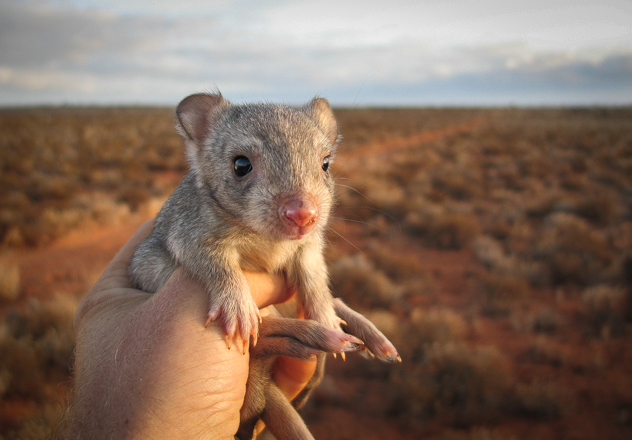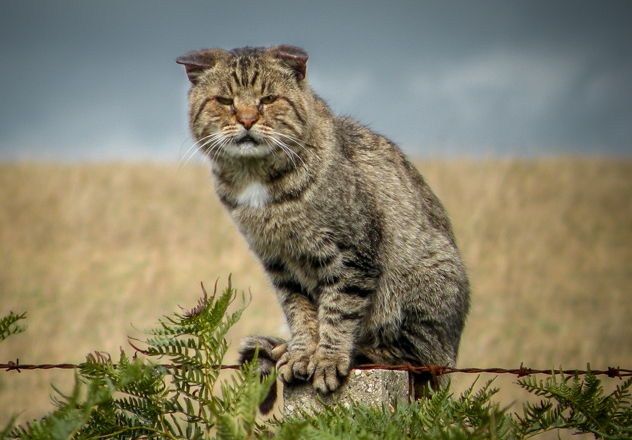Burrowing Bettongs (or often referred to as Boodies in western and southern Australia), are a small, thick-set, kangaroo-like animal and they are the only macropod to construct and permanently shelter in burrows.

 © Blair Parsons/AWC
© Blair Parsons/AWC
AWC has established populations of Burrowing Bettongs in large feral predator-free areas on Scotia and Yookamurra sanctuaries, and Faure Island. In partnership with NSW National Parks and Wildlife Service, AWC will re-introduce Burrowing Bettongs into large feral predator-free areas at Mallee Cliffs National Park. AWC also plans to reintroduce Burrowing Bettongs to Newhaven sanctuary in the future.
Across our properties, AWC ecologists employ techniques such as spotlighting and survey trapping to monitor the populations of Burrowing Bettongs. AWC also contributes to the Shark Bay Marsupials Recovery Team in Western Australia.
 © Richard Ali/Invasive Animals CRC
© Richard Ali/Invasive Animals CRC
The disappearance of Burrowing Bettongs from the mainland appears to be largely due to predation by feral cats and foxes. Hunting and poisoning by early agriculturists also significantly contributed to the species’ decline in some areas. The conservation of Burrowing Bettongs is reliant upon the establishment of feral predator-free areas on the mainland and on preventing cats and foxes from establishing on islands.
 W Lawler/AWC
W Lawler/AWC
Description
Weighing approximately 1.3 kg, Burrowing Bettongs feature short, deep muzzles and small, rounded ears. Their thick yellowish-grey fur is paler below with a lightly-haired tail that often has a white tip. As burrowing macropods, their burrows vary from simple tunnels to complex warren systems that have several entrances and many interconnecting passageways. Large warrens can support more than 20 animals, but individuals tend to forage independently.
Ecology
Like many Australian marsupials, Burrowing Bettongs are nocturnal – emerging after sunset to feed and returning to their burrow before sunrise. Individuals are omnivorous, feeding primarily on roots, tubers and fungi, but they also browse the leaves of a variety of plant species, and have been observed climbing into the lower limbs of shrubs to feed on their seeds. Breeding varies in response to rainfall but can occur at any time of the year.
Range and abundance
Once widespread across arid and semi-arid areas in the south, central and western parts of Australia, Burrowing Bettongs’ range has contracted dramatically following European settlement and the remaining populations are now only present on a small number of islands off the coast of Western Australia. Reintroductions to feral predator-free exclosures and islands have resulted in the successful establishment of a number of populations in Western Australia, New South Wales and South Australia.
Three sub-species of Burrowing Bettongs, with distinct ranges, are recognised: B. lesueur graii (mainland Australia, now extinct), B. lesueur lesueur (Bernier and Dorre Islands, Shark Bay, WA) and B. lesueur unnamed subspecies (Barrow and Boodie Islands, WA).
We need your help to save Australia's endangered animals. Your tax-deductible donation will make a difference where it really counts - in the field.
Donate Now“Scotia Wildlife Sanctuary … a vitally important project for Australia and for the planet.” – Sir David Attenborough Scotia Wildlife...
Protecting over 5,000 hectares of crucial habitat in the Murray Darling region, Yookamurra Wildlife Sanctuary is a stronghold for Australia’s...
Faure Island is part of the Shark Bay World Heritage Area, tucked between the Peron Peninsula and mainland Western Australia....
AWC helps protect a population of Kangaroo Island Dunnarts on Kangaroo Island.
Koalas inhabit eucalypt forests and woodlands in eastern Australia from north Queensland through to south-east South Australia.